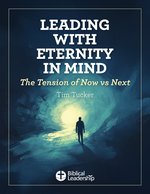Even if you’re the best preacher in the world

Preaching is mostly a one-way form of communication. In a large-group setting, those in the audience will be able to fix their attention on an effective speaker—hopefully. But this is difficult, even for the most disciplined audience members. Her baby is noisy; did he comb his hair; what’s for lunch?
If preaching is ineffective at holding one’s attention, that’s one problem. But great preaching leads to another problem: if the preacher is a rock star, the church is an audience. Even imagining a best-case scenario, avid listeners are largely passive as spectators. In fact, proclamation encourages passivity, especially with professional speakers and worship leaders putting on “a great show.”
Bill Hull argues for seeing the preacher as a pastor/teacher, rather than as a pastor/teller. “Pastor/tellers do not prepare God’s people for works of service; they talk to people about works of service…the effective telling of God’s people is a first and crucial step to their preparation…but if I stop at telling, I am not teaching.” Or as Howard Hendricks wryly notes, “If teaching were only telling, my children would be incredibly brilliant.”
As audience diversity increases, addressing a large group becomes increasingly difficult. It is challenging to know what a larger, largely-anonymous audience needs to hear, since my knowledge of them is more limited. As a church or group gets smaller, there is increased opportunity for the speaker to interact with individuals. But preaching still lacks a personal touch and is typically a shotgun manner of conveying information.
How does one craft a relevant sermon for believers and non-believers, lukewarm and passionate, old and young, married and single, and so on? It is rare that a sermon can effectively challenge a range of people. For example, if aimed at seekers and milk-drinkers, a sermon will focus on basic truths with relatively little to offer (potential) meat-eaters.
Sermons also tend to generate temporary, emotional responses. But they are quite limited in their ability to fulfill the larger goals of life change and disciple-making. A reliance on sermons for spiritual growth implicitly assumes a really low bar for “discipleship” or that discipleship will happen naturally through other means. But it’s far easier to build up church attendance through fine preaching, than to build up disciples through a process of discipleship.
Terrific preaching is fine, but limited and certainly not sufficient (or even primary) to fulfilling the Great Commission. Proclamation has its place, especially with evangelism and lower-end discipleship. Preaching is important in the life of the church, but it can only be a start—and should point people to pursue greater realities. Dallas Willard asks the pertinent questions of preachers: “Does the gospel I preach and teach have a natural tendency to cause people who hear it to become full-time students of Jesus? Would those who believe it become his apprentices as a natural ‘next step’?”
Of course, this is not to condone bad or mediocre preaching. However, in looking to fulfill the Great Commission, it’s a fatal flaw for preachers or their audiences to imagine that good preaching is the key to discipleship. Hull again: “Pastor/tellers falsely consider themselves to be teaching and equipping when they are doing no more than informing. They think they are fulfilling the Great Commission and doing their job when they engage only in the introductory elements of disciple-making.”
Do your best preaching. But make sure that you have the greater things in hand—a robust effort to disciple and equip.
Excerpted fromEnough Horses in the Barnby Kurt Sauder and D. Eric Schansberg © 2017
Photo source: istock
More on Servant Leadership
- The casualty of Christmas (by Carey Nieuwhof)
- Do you bury or bite when giving feedback? (by Miranda Carls)
- Leadership efficiency: the habit wasting your (and your team’s) time (by Christian Muntean)
- 21 signs your church needs to change (by Carey Nieuwhof)


